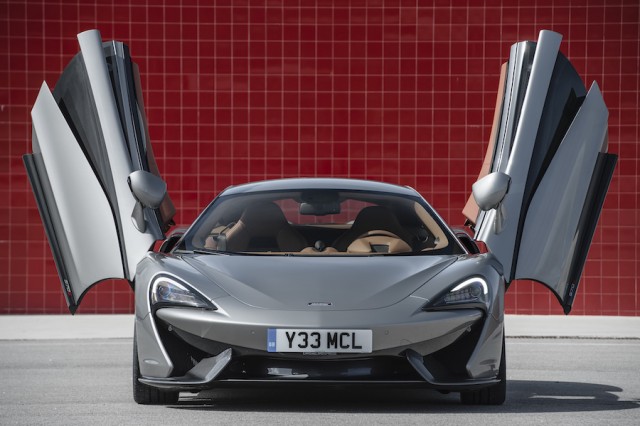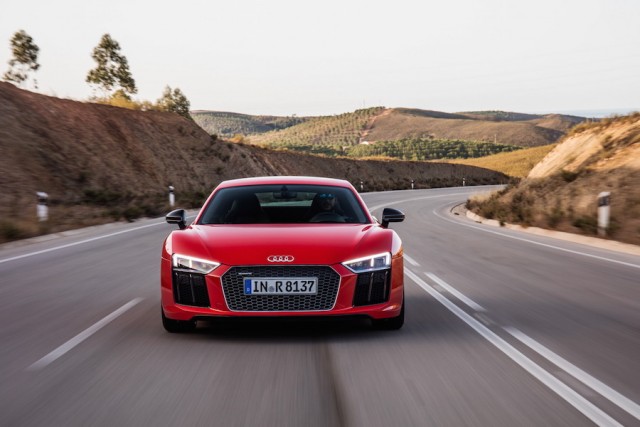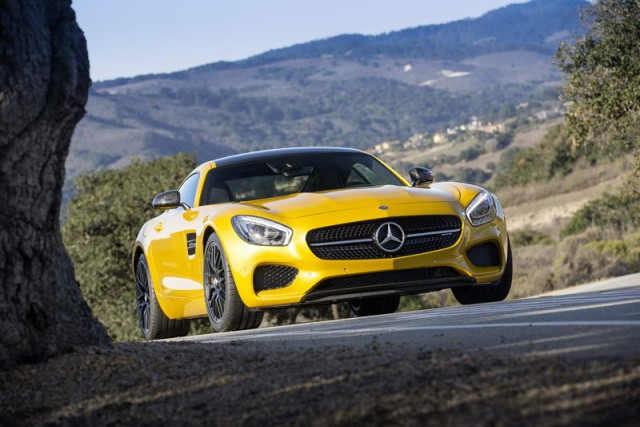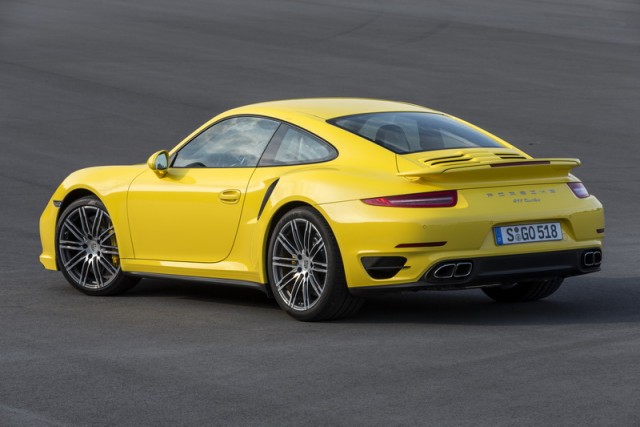Volume is what McLaren is chasing with the first of its Sports Series cars, the 570S, and it's chasing it very, very hard indeed. McLaren calls it a sports car, but it's very much in the league of super. Here's our first review.
In the metal 4/5
Why not five? It's undeniably striking, but there are elements of the McLaren 570S that are just a little bit too busy to our eyes. You're more than welcome to disagree, though, as admittedly most people seem to do. Indeed, the 570S got more thumbs up, waves and nods of appreciation on and around the roads near Faro, Portugal, than anything else we've ever driven. When the traffic's mostly made up of old white hatchbacks and vans, a supercar is always going to attract some attention and it's all positive here, even when in one of McLaren's more obnoxious hues. That could just be the happy disposition of the Portuguese locals, something that's unique to McLaren, or a mixture of both. It works best in more subtle colours, metallic tones, where its lines are a bit less extrovert. Its shape is as much to do with the stylist's eye as it is the wind-tunnel's fan. Form then, with function, though unlike its Super Series relations (such as the McLaren 650S and 675LT) the 570S does without any active aerodynamic elements, its wings all staying firmly in place rather than moving according to speed or braking requirements. That's fundamental to the 570S's brief; it's not a car that's about ultimate downforce, even if it's slippery, efficient and stable, but instead its attention is more focused on fun and interaction.
The interior is a step-change from its Super Series relations, taking elements of the McLaren P1's digital dash display (changing depending what mode you're in) and mating it to familiar McLaren round air vents, simple, yet clever form and some sharp detailing. The touch-screen infotainment system is supplemented with an array of traditional buttons along the bottom of its housing, making it quick and easy to operate, while the gearbox and driving mode selectors are all housed together between the front seats. Those seats can be manual or powered sports seats, or figure-hugging carbon fibre racing chairs - in a choice of sizes (McLaren describes the options as 'regular' for the slimmer-hipped and 'touring' for the wider). With plentiful options and complete customisation via MSO (McLaren Special Operations) if you want, the 570S can be as unique as its owner, as luxurious or sporting as you like it, and there's some useful space behind the front seats for soft luggage to supplement the reasonably-sized front luggage compartment.
Driving it 5/5
Using a development of McLaren's 3.8-litre twin-turbocharged V8 engine with 570hp the 570S might be a Sports Series model and described as a sports car, but its performance is very much in the realm of supercars. It'll reach 100km/h in 3.2 seconds and double that in 9.5 seconds, before reaching a 328km/h maximum (that's 204mph in old money). Putting that performance into perspective is its 0-200km/h time, which is just 0.1 seconds slower than recorded by the mighty McLaren F1. This, with the exception of the as yet to be driven 540C with its 3.5- and 10.5-second 0-100km/h and 0-200km/h figures respectively, is McLaren's interpretation of entry-level performance. Incredible as those figures seem, the power war is such among supercar makers that those numbers are comparable with Audi's R8 V10 Plus and Porsche's 911 Turbo S, even if the Porsche cannot quite match the two mid-engined cars for top speed.
While the majority of its competition goes with four-wheel drive, the McLaren makes do with rear-wheel drive. Any doubts that the 285-section tyres might struggle to contain the 3.8-litre twin-turbo's power and, more importantly, its 600Nm of torque, are quickly banished, the 570S demonstrating staggering traction, assisted in no small measure by the clever calibration of its stability and traction control systems. As with the Super Series models the 570S benefits from McLaren's F1 technology, doing without a limited-slip differential, McLaren instead using tricks within its electronic driver aids to allow it to exploit its not insignificant output, with the electronics assisting with variable degrees depending on your setting. It'll flatter when you're over ambitious and rein in your exuberance when in its most helpful modes, though explore the settings, through Normal, Sport, Sport Dynamic and Track, and it'll relinquish more and more control to the driver. There's an off switch too, allowing complete control if you want it.
McLaren is resolute in its message that the 570S isn't about ultimate performance, aiming instead for a more engaging road car than a track-biased, number-chasing machine. There's no emphasis on downforce at all, as the engineering team looked to create a car that's involving, interesting and enjoyable at ordinary speeds. They've been successful, too; the steering in particular a highlight. Unlike its competition the 570S's power steering is an hydraulic system, with a quicker rack than the 650S, and the benefits are tangible the instant you turn the wheel. There's beautifully measured weighting, the steering wheel's rim delivering a rich, informative level of feel that's completely absent from all but a handful of the best sports car and supercar rivals. It, as much as the engine's unending ability to pile on speed (whether at low revs or its 8,500rpm redline) defines the 570S. That the steering's precision and fine weighting is mated to a ride quality that's able to almost match its 650S relation's incredible composure, without resorting to its clever non anti-roll bar set up, is a real credit to McLaren's chassis engineers. The dampers are variable, offering three settings, though even the middle Sport setting offers a supple enough ride to be useable on the road. There's real control even when the surface is less than smooth, the 570S's trick of delivering a ride that's saloon car pliant, but sports car taut in its control.
All that allows the 570S to exploit its performance with incredible ease. The engine is never short of power and the slight lack of aural charm thanks to its forced induction is more than made up for with its massive flexibility and ever-present urge. The seven-speed paddle-shifted automatic changes gear with finger-flick immediacy in its normal modes, while the ferocity of the shift is intensified as you explore the more focused settings in the various driving modes. With all that power, its reassuring that the carbon brakes deliver repeatable, reliable stopping power - useful given the 170mph the 570S was pulling at the end of the main straight at the Portimao circuit... There, despite McLaren's remonstrations that the 570S is a road car first, it exhibited all those elements that made it so enjoyable and playful on the road, only at speeds significantly in excess of anything that might be legal among traffic. On track it'll allow, even goad, you to drive it approaching and exceeding its limits of grip and traction, its huge balance, incredible feedback and feel all making it an approachable, hugely engaging and entertaining drive.
What you get for your money 4/5
The 570S is the only car in its class to feature a carbon fibre monocoque, which not only assists with its strength and rigidity, but its weight. The 570S is, in its lightest form, 1,311kg (dry), though even if you don't tick every weight-saving carbon fibre trim item it's 1,446kg DIN - with fluids. That's all to the benefit of performance. Before you've ticked a single options box it's priced slightly above a Porsche 911 Turbo S and an Audi R8 V10 Plus, but it'll never be as common as either. Its level of sophistication takes it to another level altogether above an Aston Martin V12 Vantage S and the McLaren badge has a cachet that, while new in the road car world, is very enviable indeed.
Summary
This epic new entrant into the sports car market brings McLaren's impeccable attention to detail but resolves some of the issues we've had with its earlier Super Series cars. The 570S is so good you'd have to really want a 650S to go for it instead. This new 'volume' player is certain to ensure McLaren achieves its production growth goals. Even if it does it'll still be a rare car, which is a large part of its appeal to many. With a open-topped Spider coming in 2017, and the promise of something between then and now, McLaren's competition should be very worried indeed.


































